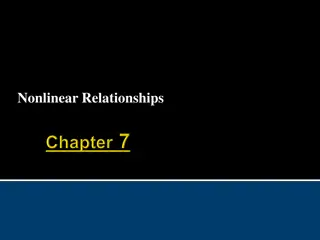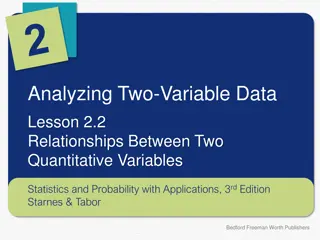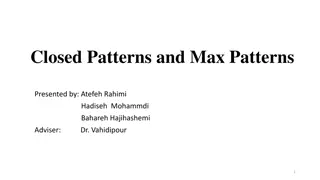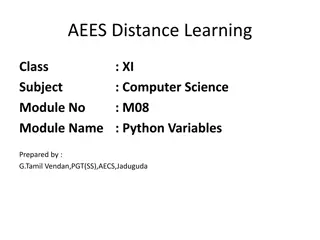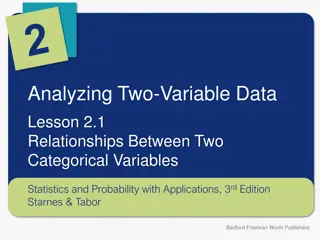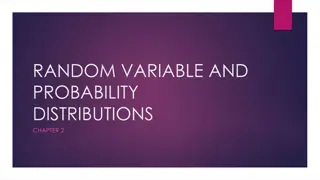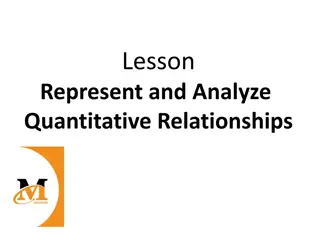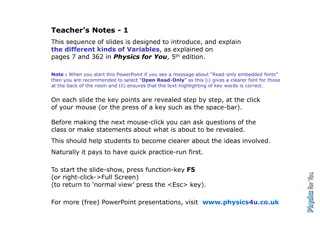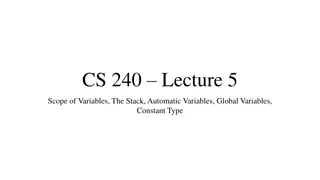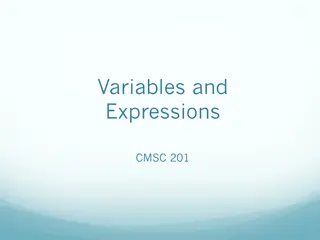Uncovering Patterns in Relationships Among Variables
Factor analysis is a statistical method used to identify clusters of variables that correlate together, aiding in evaluating construct validity and dimensions of assessments.
Download Presentation

Please find below an Image/Link to download the presentation.
The content on the website is provided AS IS for your information and personal use only. It may not be sold, licensed, or shared on other websites without obtaining consent from the author.If you encounter any issues during the download, it is possible that the publisher has removed the file from their server.
You are allowed to download the files provided on this website for personal or commercial use, subject to the condition that they are used lawfully. All files are the property of their respective owners.
The content on the website is provided AS IS for your information and personal use only. It may not be sold, licensed, or shared on other websites without obtaining consent from the author.
E N D
Presentation Transcript
Factor Analysis The purpose of factor analysis is to discover patterns in the relationships among the variables
Factor Analysis Form of multiple correlations Checking for construct validity Do questions measure the same dimension? For use between or within a test Identify items which cluster together
Correlation Matrix 1 2 3 4 5 1. Vocab 1.00 .22 .77 .20 .50 2. Algebra .22 1.00 .21 .65 .48 3. Analogy .77 .21 1.00 .19 .52 4. Geom .20 .65 .19 1.00 .47 5. Alg-wrd .50 .48 .52 .47 1.00
Factor analysis of 5 items Factors I II .101 Vocabulary .917 Algebra .113 .885 Analogy .925 Geometry .086 .891 Algebra-Word .594 % of variance 54.00 26.00 .094 .573
Factor loadings Identify clusters of questions correlations positive or negative may load on more than one factor score indicates strength of question
Types of factor analysis Exploratory factor analysis Confirmatory factor analysis
Confirmatory factor analysis Strong hypothesis -- There are two factors in this test -- questions 1-5 load onto one factor -- questions 6-10 load onto the other factor
Factor loadings - 1 Qs# Factor 1 1 .63 2 .52 3 .43 4 .89 5 .74 6 7 8 9 10 Factor 2 .36 .74 .86 .64 .52
Factor loadings - 2 Qs# Factor 1 1 .63 2 .52 3 4 .89 5 .74 6 7 8 9 .64 10 Factor 2 .43 .36 .74 .86 .52
Factor loadings - 3 Qs# Factor 1 1 .63 2 -.52 3 .43 4 .89 5 -.74 6 7 8 9 10 Factor 2 .36 .74 -.86 .64 -.52
Locus of Control 1 factor Qs# Factor 1 1 .63 2 .52 3 -.43 4 -.89 5 -.74 6 .32 7 .26 8 .75 9 .19 10 -.80
Locus of Control multiple factors Qs# 1 2 3 4 5 6 8 9 14 18 1 .56 2 3 4 5 6 .45 .34 .78 .39 .40 .67 .50 .34 .75
Need for Closure factors example Qs# 1 2 3 4 x x x x x x x x x x 45 46 47 Order Predict .xxx Decisive Ambiguity Closed minded -.xxx .xxx .xxx -.xxx .xxx -.xxx .xx .xxx .xxx -.x .xxx .xxx .xxx -.xxx .xxx -.xxx
Component Matrixa Component 1 2 3 4 5 LASSI1 .882 L5 -.802 M5 .754 -.343 L6 .738 -.331 M6 .652 -.464 .354 L4 .599 .551 -.310 .319 M8 .579 -.329 L7 -.568 -.434 .491 L2 .552 .391 .482 MSLQ1 -.364 .728 -.478 M2 -.474 .676 .315 M4 .605 -.408 .531 M7 .566 .693 L3 .374 .687 .433 M3 .488 .612 .342 L8 -.393 .405 Extraction Method: Principal Component Analysis. a. 5 components extracted.
Hypothesis This test measures 4 different factors questions 1-5 are one factor questions 6-10 are a second factor questions 11-15 are a third factor questions 16-20 are a fourth factor
Project question What do you think the factor structure of your test would look like?






